A treaty finalized by the UK may bring about the end of the .io domain. Last week, the British government announced that it has agreed to give up ownership of the Chagos Islands, a territory in the Indian Ocean it has controlled since 1814 — relinquishing the .io domain with it.
Technology
Fei-Fei Li picks Google Cloud, where she led AI, as World Labs’ main compute provider

Cloud providers are chasing after AI unicorns, and the latest is Fei-Fei Li’s World Labs. The startup just tapped Google Cloud as its primary compute provider to train AI models, a deal that could be worth hundreds of millions of dollars. But Li’s tenure as chief scientist of AI at Google Cloud wasn’t a factor, the company says.
During the Google Cloud Startup Summit on Tuesday, the companies announced World Labs will use a large chunk of its funding to license GPU servers on the Google Cloud Platform, and ultimately train “spatially intelligent” AI models.
A handful of well-funded startups building AI foundation models are highly sought after in the cloud services world. Some of the largest deals include OpenAI, which exclusively trains and runs AI models on Microsoft Azure, and Anthropic, which uses AWS and Google Cloud. These companies regularly pay millions of dollars for computing services, and could one day need even more as their AI models scale. That makes them valuable customers for Google, Microsoft, and AWS to build relationships with early on.
World Labs is certainly building unique, multimodal AI models with significant compute needs. The startup just raised $230 million at more than a billion-dollar valuation, a deal led by A16Z, in order to build AI world models. General manager of startups and AI at Google Cloud, James Lee, tells TechCrunch that World Labs’ AI models will one day be able to process, generate, and interact with video and geospatial data. World Labs calls these AI models “spatial intelligence.”
Li has deep ties with Google Cloud, having led the company’s AI efforts in 2018. However, Google denies that this deal is a product of that relationship, and rejects the idea that cloud services are just commodities. Instead, Lee said services, such as its High Performance Toolkit to scale AI workloads, and its deep supply of AI chips were a larger factor.
“Fei-Fei is obviously a friend of GCP,” said Lee in an interview. “GCP wasn’t the only option they looked at. But for all the reasons we talked about – our AI optimized infrastructure and the ability to meet their scalability needs – ultimately they came to us.”
Google Cloud offers AI startups a choice between its proprietary AI chips, tensor processing units or TPUs, and Nvidia’s GPUs, which Google purchases and has a more limited supply of. Google Cloud is trying to get more startups to train AI models on TPUs, largely as a means to reduce its dependency on Nvidia. All cloud providers are limited today by the scarcity of Nvidia GPUs, so many are building their own AI chips to meet demand. Google Cloud says some startups are training and inferencing solely on TPUs, however, GPUs still remain the industry’s favorite AI training chip.
World Labs chose to train its AI models on GPUs in this deal. However, Google Cloud wouldn’t say what went into that decision.
“We worked with Fei-Fei and her product team, and at this stage of their product roadmap, it made more sense for them to work with us on the GPU platform,” said Lee in an interview. “But it doesn’t necessarily mean it’s a permanent decision… Sometimes [startups] move onto different platforms, such as TPUs.”
Lee would not disclose how large World Labs’ GPU cluster is, but cloud providers often dedicate massive supercomputers for startups training AI models. Google Cloud promised another startup training AI foundation models, Magic, a cluster with “tens of thousands of Blackwell GPUs,” each of which has more power than a high-end gaming PC.
These clusters are easier to promise than they are to fulfill. Google’s cloud services competitor Microsoft is reportedly struggling to meet the insane compute demands of OpenAI, forcing the startup to tap other options for computing power.
World Labs’ deal with Google Cloud is not exclusive, meaning the startup may still strike deals with other cloud providers. However, Google Cloud says it will get a majority of its business moving forward.
Science & Environment
Wildlife Photographer of the Year: Tadpoles win top prize
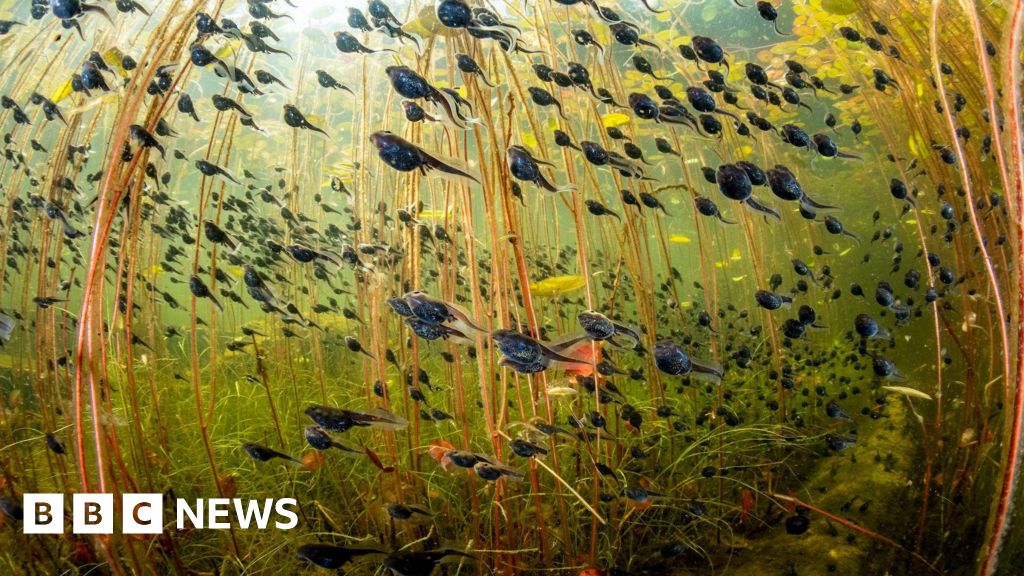
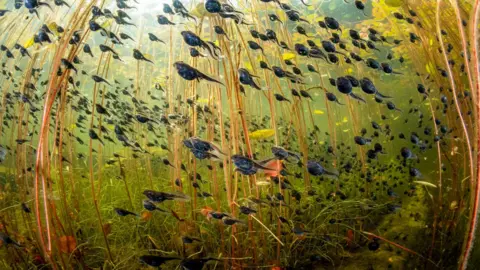 Shane Gross
Shane GrossA snapshot of wriggling toad tadpoles has earned Shane Gross the title of Wildlife Photographer of the Year.
Beneath a floating canopy of lily pads in Cedar Lake, Canada, a swarm of western toad tadpoles glided gracefully through the water.
“To me, the most fun that I can have, the thing that lights me up inside, is to see something new and try to photograph it in the best way I possibly can,” Shane told BBC News.
His careful movements through the delicate layer of silt and algae at the lake’s bottom ensured a clear view.
“I had no idea if I had anything good at all until I got home,” he said. “But when I finally looked, I was like, wow, this is pretty cool.”
Within four to twelve weeks after hatching, these little tadpoles begin their transformation into toads, with only about 1% making it to adulthood.
He was awarded the prize at London’s Natural History Museum.
“This image swirls with light, energy and a feeling of synchronised movement between the lilies and the tadpole tails,” said Kathy Moran, Jury Chair and Editor. “The real payoff is that this wonderful scene highlights environments and species that are often overlooked.”
Scroll on to see all of the winning photographs.
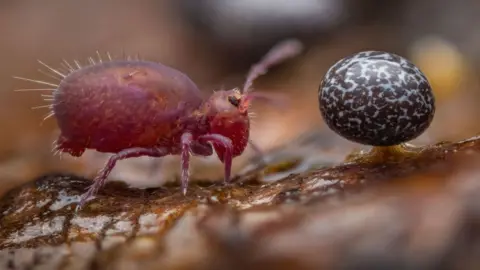 Alexis Tinker-Tsavalas
Alexis Tinker-TsavalasAlexis Tinker-Tsavalas, 17, from Germany, won the Young Wildlife Photographer of the Year title. His photo “Life Under Dead Wood” featured fruiting slime mould alongside a tiny, energetic springtail.
Working quickly was essential, as these tiny critters can leap several times their body length in the blink of an eye.
“I think a lot of people don’t know that these things even exist,” Alexis said. “If people learn more through my images, I feel like that’s one of the biggest goals for me, to just show this tiny world that a lot of people don’t really get to see, in a different light.”
Using a technique known as focus-stacking, he combined 36 images into one stunning photograph.
These miniature springtails, under two millimetres long, are found alongside slime moulds worldwide, munching on microorganisms and playing a key role in soil health.
Category winners
Dusting for New Evidence by Britta Jaschinski, Germany/UK
 Britta Jaschinski
Britta JaschinskiBritta Jaschinski observed as a crime scene investigator from London’s Metropolitan Police dusted a confiscated tusk at Heathrow Airport for fingerprints, using newly developed magnetic powder.
Under the Waterline by Matthew Smith, UK/Australia
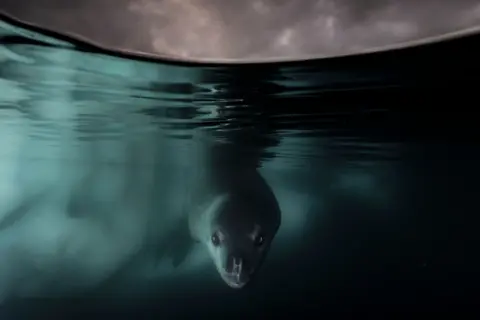 Matthew Smith
Matthew SmithMatthew Smith captured a striking split image of a curious leopard seal beneath the Antarctic ice, using a custom extension he designed for his camera’s underwater housing.
Dolphins of the Forest by Thomas Peschak, Germany/South Africa
 Thomas Peschak
Thomas PeschakThe Amazon River dolphin, one of two freshwater dolphin species in the Amazon and Orinoco basins, uniquely adapts to explore seasonally flooded forest habitats.
Thomas Peschak highlights the endangered dolphins’ complex relationship with local communities and the challenges they face due to human interactions that disrupt their natural behaviours.
Tiger in Town by Robin Darius Conz, Germany
 Robin Darius Conz
Robin Darius ConzWhile filming a wildlife documentary in India’s western ghats, Robin Darius Conz saw a tiger on a hillside overlooking a town. He used a drone to track the tiger, to highlight the contrast between protected areas and those affected by human development.
A Tranquil Moment by Hikkaduwa Liyanage Prasantha Vinod, Sri Lanka
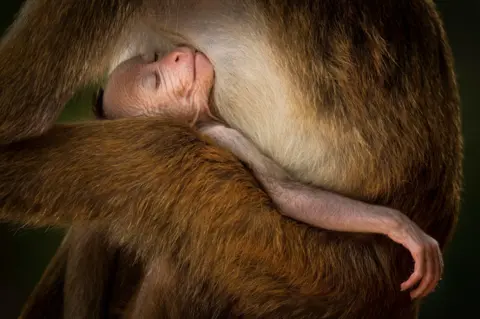 Hikkaduwa Liyanage Prasantha Vinod
Hikkaduwa Liyanage Prasantha VinodAfter photographing birds and leopards, Hikkaduwa Liyanage Prasantha Vinod captured a young toque macaque peacefully sleeping in an adult’s arms to highlight the challenges these monkeys face amid habitat loss and farmer conflicts.
The Demolition Squad by Ingo Arndt, Germany
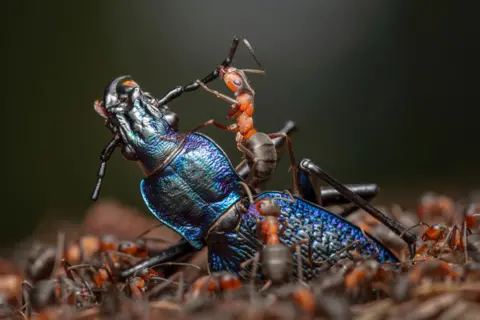 Ingo Arndt
Ingo ArndtIngo Arndt captured the red wood ants efficiently dismembering a blue ground beetle to carry into their nest. He described himself as “full of ant” after just a few minutes lying beside the ants’ nest as he watched their teamwork in action.
Free as a Bird by Alberto Román Gómez, Spain
 Alberto Román Gómez
Alberto Román GómezAlberto Román Gómez captured a playful stonechat perched beside a heavy chain, resembling a tiny warrior. From his father’s car in Sierra de Grazalema Natural Park, he struggled to photograph the bird as it darted about, gathering insects.
Frontier of the Lynx by Igor Metelskiy, Russia
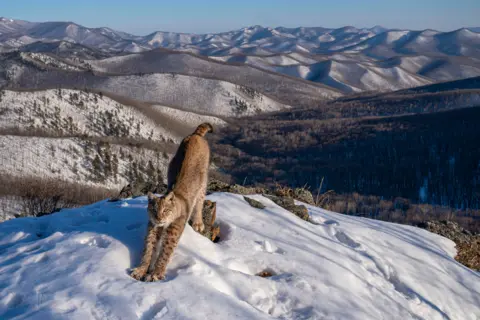 Igor Metelskiy
Igor MetelskiyMr Metelskiy captured a serene image of a lynx stretching in the evening sun, blending into the wilderness. After over six months of patience, he positioned his camera trap near the footprints of potential prey, revealing the elusive lynx in its natural habitat.
Old Man of the Glen by Fortunato Gatto, Italy
 Fortunato Gatto
Fortunato GattoFortunato Gatto came across a gnarled birch tree draped with pale ‘old man’s beard’ lichens in Glen Affric in the Scottish highlands. Glen Affric is home to the highest concentration of native trees in the UK, making it a vital ecosystem.
Practice Makes Perfect by Jack Zhi, USA
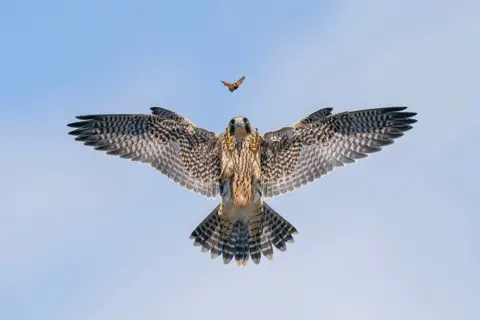 Jack Zhi
Jack Zhi Jack Zhi captures a young falcon practicing hunting on a butterfly near its sea-cliff nest. For the past eight years, he observed the birds in this area, but tracking them was particularly challenging as they were so fast.
The Artful Crow by Jiří Hřebíček, Czech Republic
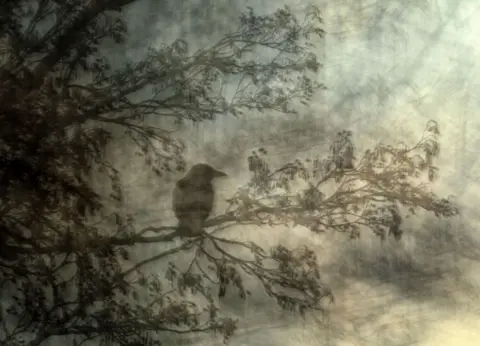 Jiří Hřebíček
Jiří HřebíčekJiří Hřebíček created an artistic image of a carrion crow by using a long shutter speed while moving his camera on purpose.
On Watch by John E Marriott, Canada
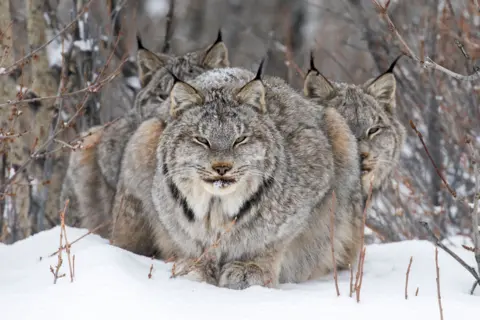 John E Marriott
John E MarriottJohn Marriott photographs a lynx resting, with its fully grown young sheltering from the cold wind behind it. After a week of tracking led him to the group, he kept his distance to avoid disturbing the family in the snowy forest.
A Diet of Deadly Plastic by Justin Gilligan, Australia
 Justin Gilligan
Justin GilliganJustin Gilligan created a mosaic from 403 pieces of plastic found in the digestive tract of a dead flesh-footed shearwater. He has been documenting research from a team that studies the impact of plastic pollution on marine ecosystems.
An Evening Meal by Parham Pourahmad, USA
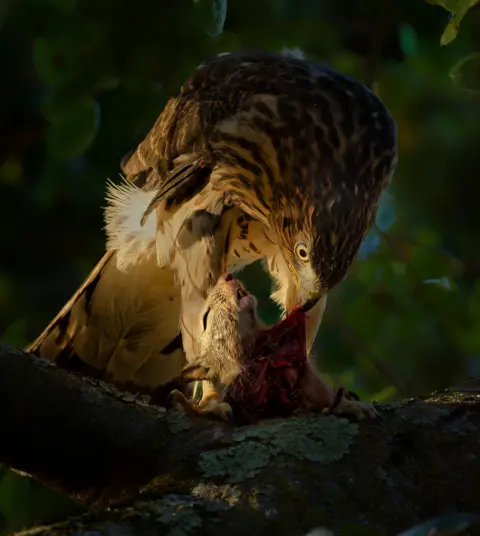 Parham Pourahmad
Parham PourahmadParham Pourahmad watched the last rays of sunlight highlight a young Cooper’s hawk eating a squirrel. Over the summer, he photographed wildlife in a city park to show that “nature will always be wild and unpredictable”.
Wetland Wrestle by Karine Aigner, USA
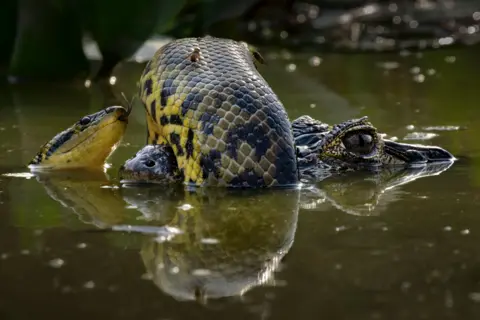 Karine Aigner
Karine AignerKarine Aigner spotted a yellow anaconda coiled around the snout of a yacaré caiman while leading a tour group. She observed the two reptiles struggling, uncertain which was the aggressor, while horseflies clung to the snake’s back.
The Serengeti of the Sea by Sage Ono, USA
 Sage Ono
Sage OnoTube-snout fish eggs glimmer among golden kelp, their colours fading as they develop. Sage Ono, inspired by his grandfather’s marine biology stories, captures the unique underwater life of Monterey Bay’s giant kelp forests.
“I like small and weird. So, when I saw the eggs and the kelp, I was like, okay, this is something I don’t have a photograph of. I’ve never really seen a photograph of it, so it’s really interesting to me.” Sage said.
Technology
Prime Day Anker deals include big savings on power banks and chargers during October Big Deal Days

Anker makes some of our favorite charging gear and mobile accessories, and it’s almost guaranteed that you’ll be able to find good discounts on the company’s products during an event like October Prime Day. Whether you’ve been on the hunt for a docking station for your laptop, want a new magnetic wireless charger for your next trip or just need another charging cable to replace the last one you misplaced, Prime Day deals on Anker devices should be able to help. We’re seeing some of our favorite Anker accessories on sale for record-low (or close to them) prices. While there’s always the chance that these deals come back around in a month for Black Friday, we recommend grabbing what you want now while the deals are available. These are the best Prime Day deals on Anker gear that we found for October Prime Day.
Prime Day deals on Anker magnetic charging gear
Particularly if you have an iPhone with MagSafe support, magnetic accessories can make charging up your phone even easier. On sale this time around are wireless, magnetic power banks and charging stations that can support multiple devices at once.
Prime Day deals on Anker charging cables and adapters
Prime Day, or any big sale event for that matter, is a good opportunity to pick up a few extra essentials like charging cables while you can get them at a discount. Anker’s offerings right now include deals on USB-C and Lightning cables, along with charging adapters in various sizes and max wattages.
Prime Day deals on Anker docking stations, hubs and more
Anker may be known for its charging gear, but the company makes other accessories like docking stations and webcams, too. Prime Day deals include deep discounts on hubs and stations that add a bunch of extra ports back into the mix, and one of our favorite webcams.
-
Anker 8-in-1 USB-C hub/foldable tablet stand for $80 ($20 off): This handy stand can make it much easier to turn your iPad or other tablet into a laptop replacement. It supports passthrough charging and has eight different connectors including a microSD card slot, a 3.5mm audio jack and two USB-A ports.
-
Anker 14-in-1 USB-C docking station for $54 ($21 off): If you need a lot of connectivity on the go, this 14-in-1 hub could be a good option. Not only does it include an Ethernet port, but it also has two HDMI connectors and supports 80W passthrough charging.
-
Anker 13-in-1 USB-C docking station for $140 ($30 off): A docking station like this one make your work-from-home setup more efficient. Here, you get pretty much every connector you’d need, including Ethernet, Display and HDMI ports, multiple USB-A ports, an audio jack and more. Plus, the docking station supports 85W charging for your laptop while it’s connected.
-
Anker 10-in-1 USB-C docking station for $150 ($40 off): This slim docking station provides three USB-A ports, two HDMI ports and a DisplayPort, along with an Ethernet jack and up to 100W of charging for your laptop.
-
Anker PowerConf C200 2K webcam for $48 ($12 off): One of our top picks for the best webcams, this accessory records 2K video and has dual stereo microphones plus an adjustable field of view.
Expired Prime Day deals
Follow @EngadgetDeals on Twitter for the latest tech deals and buying advice, and stay tuned to Engadget.com for all of the best tech deals coming out of October Prime Day 2024.
Servers computers
CERTECH Benchmark Server Rack – 800mm Wide
Technology
How a UK treaty could spell the end of the .io domain

But first, let’s take a step back (and I mean far back) to see how we got here. According to the Encyclopedia Britannica, the Chagos Islands were settled by the French in the 1700s, who brought slaves to the archipelago. In 1814, the French ceded control of the Chagos Islands and the island country of Mauritius to the British. When the British took over, the Chagos Islands remained a dependency of Mauritius.
In 1965, the UK granted Mauritius its sovereignty, but the government decided to split off the Chagos Islands, making it a British Indian Ocean Territory. The UK ended up forcibly removing the Chagossian people so the US could build a military base on one of the islands, displacing more than 1,500 people, as detailed in this report from Human Rights Watch.
Eventually, the Chagos Islands — or the British Indian Ocean Territory — were given the IO country code. It was also assigned a matching .io country code domain in 1997. The British government granted the rights to sell .io domains to the Internet Computer Bureau (ICB), according to a 2014 report from GigaOm.
A country’s government is typically supposed to receive revenue for any sites that register using their country code domain. For example, Anguilla, which has the country code AI, was projected to make between $25 million and $30 million last year from websites registering with the .ai domain.
The IANA aims to retire old country code domains within five years
You’d think the Chagos Islands would make similar amounts of money from the .io domain. After all, thousands of buzzy tech startups and cryptocurrency companies — like itch.io, greenhouse.io, and opensea.io — adopted the domain, since “io” also serves as an abbreviation for “input/output.”
However, entrepreneur Paul Kane, who previously ran the ICB, told GigaOm that the British government collected some of the revenue, which came as a surprise to the Chagossian people. In 2020, the Chagossians submitted a claim to gain ownership of what they said was a $50 million property, as reported by Fortune.
But now, the UK’s finalized agreement will make the Chagos Islands part of Mauritius — a move Chagossians say the government didn’t even consult them on. With this change, the British Indian Ocean Territory is no more, calling into question the future of the .io domain.
As pointed out by the Every newsletter, the Internet Assigned Numbers Authority (IANA) has a process for retiring old country code domains within five years (with the possibility for extensions). The IANA established this rule after the Soviet Union’s .su domain lingered after its collapse, becoming a domain commonly used among cybercriminals.
Since then, IANA has also had to retire the .yu domain previously used for Yugoslavia, but it remained operational for years following the country’s breakup while government websites transitioned to new domains. And while the independent Solomon Islands does have the domain name .sb, where “B” stands for how it used to be a British protectorate, that domain was registered decades after it achieved independence. The UK still has the inactive .gb domain as well, but it’s considering getting rid of it.
For now, it’s still too early to tell what will become of the .io domain — whether it will go through a similar transitional period like .yu, or if the IANA will just let the Chagossans keep it. The Verge reached out to Identity Digital — the domain registrar that previously obtained the rights to sell .io domains — and IANA for information about .io’s future. We didn’t immediately hear back.
Servers computers
Anurag Gurtu Introduces the UCS-E Data Center-Class Blade Server
Technology
Quordle today – hints and answers for Wednesday, October 9 (game #989)

Quordle was one of the original Wordle alternatives and is still going strong now nearly 1,000 games later. It offers a genuine challenge, though, so read on if you need some Quordle hints today – or scroll down further for the answers.
Enjoy playing word games? You can also check out my Wordle today, NYT Connections today and NYT Strands today pages for hints and answers for those puzzles.
SPOILER WARNING: Information about Quordle today is below, so don’t read on if you don’t want to know the answers.

Quordle today (game #989) – hint #1 – Vowels
How many different vowels are in Quordle today?
• The number of different vowels in Quordle today is 5*.
* Note that by vowel we mean the five standard vowels (A, E, I, O, U), not Y (which is sometimes counted as a vowel too).
Quordle today (game #989) – hint #2 – repeated letters
Do any of today’s Quordle answers contain repeated letters?
• The number of Quordle answers containing a repeated letter today is 0.
Quordle today (game #989) – hint #3 – uncommon letters
Do the letters Q, Z, X or J appear in Quordle today?
• No. None of Q, Z, X or J appear among today’s Quordle answers.
Quordle today (game #989) – hint #4 – starting letters (1)
Do any of today’s Quordle puzzles start with the same letter?
• The number of today’s Quordle answers starting with the same letter is 2.
If you just want to know the answers at this stage, simply scroll down. If you’re not ready yet then here’s one more clue to make things a lot easier:
Quordle today (game #989) – hint #5 – starting letters (2)
What letters do today’s Quordle answers start with?
• T
• H
• D
• T
Right, the answers are below, so DO NOT SCROLL ANY FURTHER IF YOU DON’T WANT TO SEE THEM.
Quordle today (game #989) – the answers
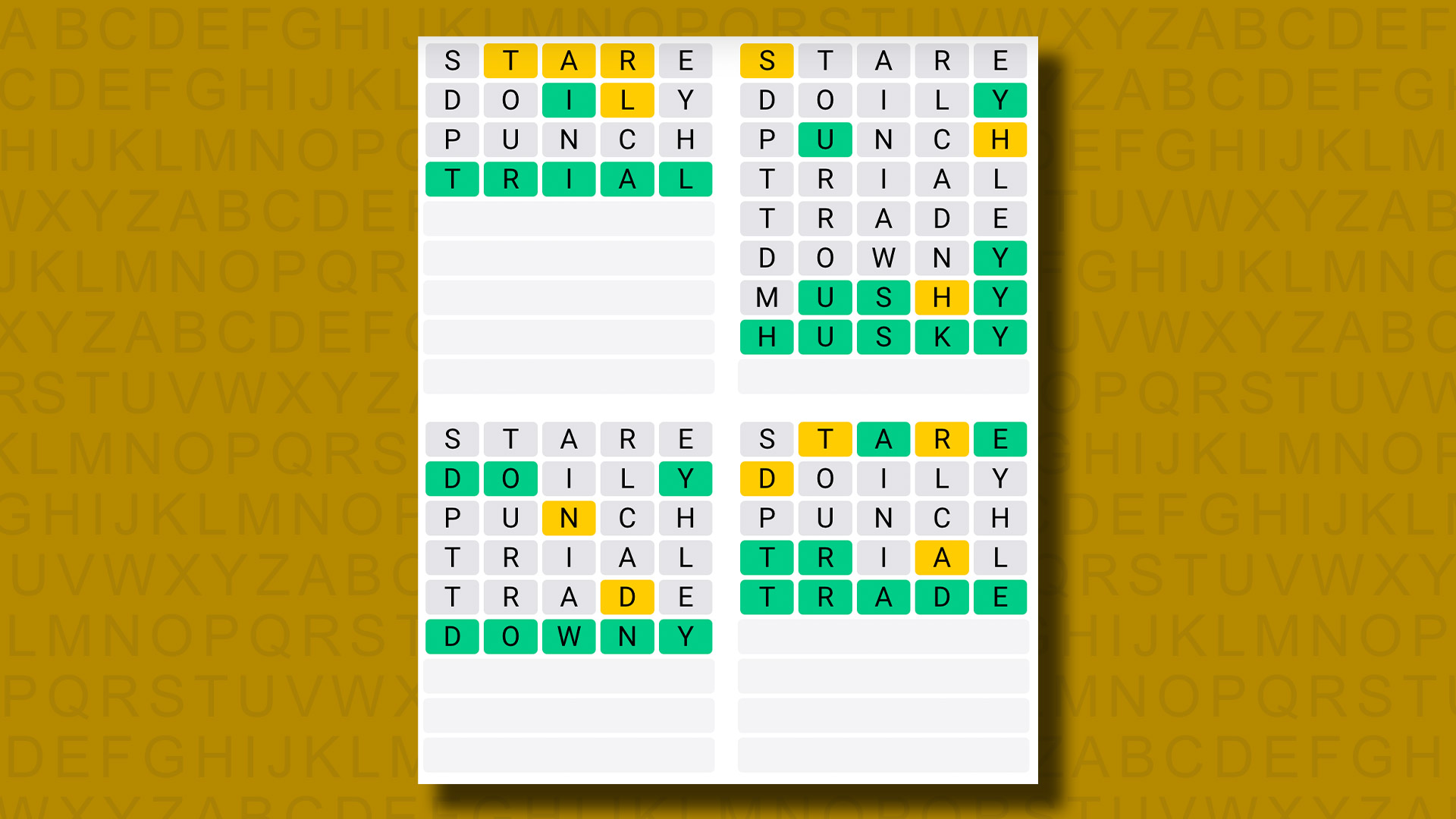
The answers to today’s Quordle, game #989, are…
The HUSKY would be in my top 10 of dogs, an important list that is (of course) topped by my own chocolate labrador. It wasn’t necessarily my favorite Quordle word today, though, on account of it being slightly more difficult than the others here; that -US-Y format could also be BUSHY or MUSHY or PUSHY, so I needed a guess to narrow it down.
How did you do today? Send me an email and let me know.
Daily Sequence today (game #989) – the answers
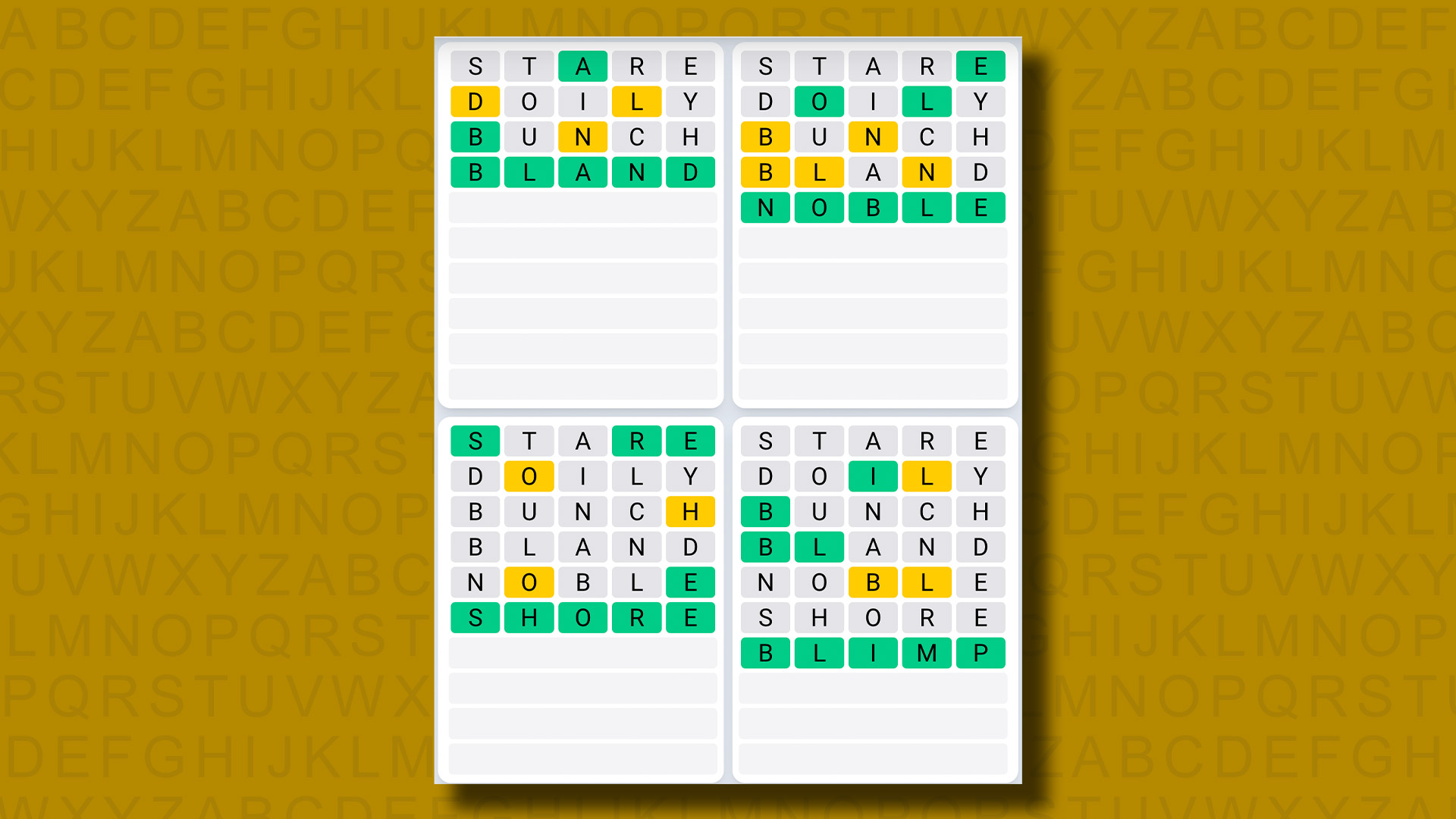
The answers to today’s Quordle Daily Sequence, game #989, are…
Quordle answers: The past 20
- Quordle #988, Tuesday 8 October: TROUT, HATER, BARGE, DOZEN
- Quordle #987, Monday 7 October: CAULK, HALVE, APING, HEATH
- Quordle #986, Sunday 6 October: FUDGE, TENOR, BEGAT, ROUSE
- Quordle #985, Saturday 5 October: ELECT, CROAK, FRISK, JAUNT
- Quordle #984, Friday 4 October: ELFIN, GRAIL, PATIO, RECAP
- Quordle #983, Thursday 3 October: TENTH, REMIT, CURVE, TOAST
- Quordle #982, Wednesday 2 October: ARGUE, CRANE, TOKEN, PRINT
- Quordle #981, Tuesday 1 October: FRILL, MADLY, GRANT, NYLON
- Quordle #980, Monday 30 September: CRUSH, TARDY, TEACH, STUMP
- Quordle #979, Sunday 29 September: SERIF, BORNE, WRITE, SLEEK
- Quordle #978, Saturday 28 September: BUSHY, CIVIC, SNOUT, EQUIP
- Quordle #977, Friday 27 September: GUEST, CHASM, ROOST, BASAL
- Quordle #976, Thursday 26 September: STAGE, VOGUE, CLUMP, HEATH
- Quordle #975, Wednesday 25 September: UMBRA, DADDY, GLAZE, PRANK
- Quordle #974, Tuesday 24 September: SPACE, INNER, SPAWN, BEGAT
- Quordle #973, Monday 23 September: GUILT, STERN, ANNEX, FIELD
- Quordle #972, Sunday 22 September: ZESTY, MEATY, ALIVE, DRAWN
- Quordle #971, Saturday 21 September: VITAL, FRAIL, SPEAR, EERIE
- Quordle #970, Friday 20 September: ELIDE, DITTO, SHAWL, BONUS
- Quordle #969, Thursday 19 September: MARRY, OWING, DICEY, LUCKY
-

 Womens Workouts2 weeks ago
Womens Workouts2 weeks ago3 Day Full Body Women’s Dumbbell Only Workout
-

 Science & Environment3 weeks ago
Science & Environment3 weeks agoHow to unsnarl a tangle of threads, according to physics
-

 Science & Environment3 weeks ago
Science & Environment3 weeks agoHyperelastic gel is one of the stretchiest materials known to science
-

 Technology3 weeks ago
Technology3 weeks agoWould-be reality TV contestants ‘not looking real’
-

 Science & Environment3 weeks ago
Science & Environment3 weeks ago‘Running of the bulls’ festival crowds move like charged particles
-

 Science & Environment3 weeks ago
Science & Environment3 weeks agoMaxwell’s demon charges quantum batteries inside of a quantum computer
-

 News2 weeks ago
News2 weeks agoOur millionaire neighbour blocks us from using public footpath & screams at us in street.. it’s like living in a WARZONE – WordupNews
-
News3 weeks ago
the pick of new debut fiction
-

 Science & Environment3 weeks ago
Science & Environment3 weeks agoHow to wrap your mind around the real multiverse
-

 Science & Environment3 weeks ago
Science & Environment3 weeks agoQuantum ‘supersolid’ matter stirred using magnets
-

 Science & Environment3 weeks ago
Science & Environment3 weeks agoSunlight-trapping device can generate temperatures over 1000°C
-

 Science & Environment3 weeks ago
Science & Environment3 weeks agoLiquid crystals could improve quantum communication devices
-

 Science & Environment3 weeks ago
Science & Environment3 weeks agoITER: Is the world’s biggest fusion experiment dead after new delay to 2035?
-

 Science & Environment3 weeks ago
Science & Environment3 weeks agoQuantum forces used to automatically assemble tiny device
-

 Science & Environment3 weeks ago
Science & Environment3 weeks agoPhysicists are grappling with their own reproducibility crisis
-

 Science & Environment3 weeks ago
Science & Environment3 weeks agoWhy this is a golden age for life to thrive across the universe
-

 News3 weeks ago
News3 weeks agoYou’re a Hypocrite, And So Am I
-

 Sport3 weeks ago
Sport3 weeks agoJoshua vs Dubois: Chris Eubank Jr says ‘AJ’ could beat Tyson Fury and any other heavyweight in the world
-

 Science & Environment3 weeks ago
Science & Environment3 weeks agoCaroline Ellison aims to duck prison sentence for role in FTX collapse
-
Business1 week ago
Eurosceptic Andrej Babiš eyes return to power in Czech Republic
-

 Science & Environment3 weeks ago
Science & Environment3 weeks agoTime travel sci-fi novel is a rip-roaringly good thought experiment
-

 Science & Environment3 weeks ago
Science & Environment3 weeks agoLaser helps turn an electron into a coil of mass and charge
-

 Science & Environment3 weeks ago
Science & Environment3 weeks agoNuclear fusion experiment overcomes two key operating hurdles
-

 Science & Environment3 weeks ago
Science & Environment3 weeks agoNerve fibres in the brain could generate quantum entanglement
-

 Technology2 weeks ago
Technology2 weeks ago‘From a toaster to a server’: UK startup promises 5x ‘speed up without changing a line of code’ as it plans to take on Nvidia, AMD in the generative AI battlefield
-

 Football1 week ago
Football1 week agoFootball Focus: Martin Keown on Liverpool’s Alisson Becker
-

 Science & Environment3 weeks ago
Science & Environment3 weeks agoRethinking space and time could let us do away with dark matter
-

 News3 weeks ago
News3 weeks ago▶️ Hamas in the West Bank: Rising Support and Deadly Attacks You Might Not Know About
-

 Science & Environment2 weeks ago
Science & Environment2 weeks agoX-rays reveal half-billion-year-old insect ancestor
-

 MMA2 weeks ago
MMA2 weeks agoConor McGregor challenges ‘woeful’ Belal Muhammad, tells Ilia Topuria it’s ‘on sight’
-

 News3 weeks ago
News3 weeks ago▶️ Media Bias: How They Spin Attack on Hezbollah and Ignore the Reality
-
Business2 weeks ago
Should London’s tax exiles head for Spain, Italy . . . or Wales?
-

 Science & Environment3 weeks ago
Science & Environment3 weeks agoA slight curve helps rocks make the biggest splash
-

 News3 weeks ago
News3 weeks agoNew investigation ordered into ‘doorstep murder’ of Alistair Wilson
-

 News3 weeks ago
News3 weeks agoIsrael strikes Lebanese targets as Hizbollah chief warns of ‘red lines’ crossed
-

 Science & Environment3 weeks ago
Science & Environment3 weeks agoFuture of fusion: How the UK’s JET reactor paved the way for ITER
-

 Science & Environment3 weeks ago
Science & Environment3 weeks agoA new kind of experiment at the Large Hadron Collider could unravel quantum reality
-

 Science & Environment3 weeks ago
Science & Environment3 weeks agoUK spurns European invitation to join ITER nuclear fusion project
-

 CryptoCurrency3 weeks ago
CryptoCurrency3 weeks agoCardano founder to meet Argentina president Javier Milei
-

 News2 weeks ago
News2 weeks agoWhy Is Everyone Excited About These Smart Insoles?
-

 Science & Environment2 weeks ago
Science & Environment2 weeks agoMeet the world's first female male model | 7.30
-

 Technology2 weeks ago
Technology2 weeks agoGet ready for Meta Connect
-

 Health & fitness2 weeks ago
Health & fitness2 weeks agoThe 7 lifestyle habits you can stop now for a slimmer face by next week
-

 Health & fitness3 weeks ago
Health & fitness3 weeks agoThe maps that could hold the secret to curing cancer
-

 Science & Environment3 weeks ago
Science & Environment3 weeks agoWhy we need to invoke philosophy to judge bizarre concepts in science
-

 CryptoCurrency3 weeks ago
CryptoCurrency3 weeks agoLow users, sex predators kill Korean metaverses, 3AC sues Terra: Asia Express
-
Politics3 weeks ago
UK consumer confidence falls sharply amid fears of ‘painful’ budget | Economics
-

 Womens Workouts3 weeks ago
Womens Workouts3 weeks agoBest Exercises if You Want to Build a Great Physique
-

 Womens Workouts3 weeks ago
Womens Workouts3 weeks agoEverything a Beginner Needs to Know About Squatting
-

 News2 weeks ago
News2 weeks agoFour dead & 18 injured in horror mass shooting with victims ‘caught in crossfire’ as cops hunt multiple gunmen
-

 Technology2 weeks ago
Technology2 weeks agoRobo-tuna reveals how foldable fins help the speedy fish manoeuvre
-

 Technology2 weeks ago
Technology2 weeks agoQuantum computers may work better when they ignore causality
-

 Sport1 week ago
Sport1 week agoWatch UFC star deliver ‘one of the most brutal knockouts ever’ that left opponent laid spark out on the canvas
-

 CryptoCurrency3 weeks ago
CryptoCurrency3 weeks agoEthereum is a 'contrarian bet' into 2025, says Bitwise exec
-

 Health & fitness3 weeks ago
Health & fitness3 weeks agoThe secret to a six pack – and how to keep your washboard abs in 2022
-
Business3 weeks ago
JPMorgan in talks to take over Apple credit card from Goldman Sachs
-

 Science & Environment3 weeks ago
Science & Environment3 weeks agoQuantum time travel: The experiment to ‘send a particle into the past’
-

 Science & Environment3 weeks ago
Science & Environment3 weeks agoBeing in two places at once could make a quantum battery charge faster
-

 Science & Environment3 weeks ago
Science & Environment3 weeks agoA tale of two mysteries: ghostly neutrinos and the proton decay puzzle
-

 CryptoCurrency3 weeks ago
CryptoCurrency3 weeks agoBitcoin miners steamrolled after electricity thefts, exchange ‘closure’ scam: Asia Express
-

 CryptoCurrency3 weeks ago
CryptoCurrency3 weeks agoDorsey’s ‘marketplace of algorithms’ could fix social media… so why hasn’t it?
-

 CryptoCurrency3 weeks ago
CryptoCurrency3 weeks agoDZ Bank partners with Boerse Stuttgart for crypto trading
-

 CryptoCurrency3 weeks ago
CryptoCurrency3 weeks agoBitcoin bulls target $64K BTC price hurdle as US stocks eye new record
-

 CryptoCurrency3 weeks ago
CryptoCurrency3 weeks agoBlockdaemon mulls 2026 IPO: Report
-
News3 weeks ago
The Project Censored Newsletter – May 2024
-

 TV2 weeks ago
TV2 weeks agoCNN TÜRK – 🔴 Canlı Yayın ᴴᴰ – Canlı TV izle
-

 Science & Environment2 weeks ago
Science & Environment2 weeks agoCNN TÜRK – 🔴 Canlı Yayın ᴴᴰ – Canlı TV izle
-

 Womens Workouts2 weeks ago
Womens Workouts2 weeks ago3 Day Full Body Toning Workout for Women
-

 Servers computers2 weeks ago
Servers computers2 weeks agoWhat are the benefits of Blade servers compared to rack servers?
-

 News2 weeks ago
News2 weeks agoUS Newspapers Diluting Democratic Discourse with Political Bias
-

 Technology2 weeks ago
Technology2 weeks agoThe best robot vacuum cleaners of 2024
-

 News3 weeks ago
News3 weeks agoChurch same-sex split affecting bishop appointments
-

 Politics3 weeks ago
Politics3 weeks agoTrump says he will meet with Indian Prime Minister Narendra Modi next week
-

 Sport3 weeks ago
Sport3 weeks agoUFC Edmonton fight card revealed, including Brandon Moreno vs. Amir Albazi headliner
-

 Science & Environment3 weeks ago
Science & Environment3 weeks agoHow one theory ties together everything we know about the universe
-

 News3 weeks ago
News3 weeks agoBrian Tyree Henry on voicing young Megatron, his love for villain roles
-

 Technology3 weeks ago
Technology3 weeks agoThe ‘superfood’ taking over fields in northern India
-

 Science & Environment3 weeks ago
Science & Environment3 weeks agoTiny magnet could help measure gravity on the quantum scale
-

 Science & Environment3 weeks ago
Science & Environment3 weeks agoHow do you recycle a nuclear fusion reactor? We’re about to find out
-

 CryptoCurrency3 weeks ago
CryptoCurrency3 weeks agoDecentraland X account hacked, phishing scam targets MANA airdrop
-

 CryptoCurrency3 weeks ago
CryptoCurrency3 weeks agoRedStone integrates first oracle price feeds on TON blockchain
-

 CryptoCurrency3 weeks ago
CryptoCurrency3 weeks ago‘No matter how bad it gets, there’s a lot going on with NFTs’: 24 Hours of Art, NFT Creator
-
Business3 weeks ago
Thames Water seeks extension on debt terms to avoid renationalisation
-
Business3 weeks ago
How Labour donor’s largesse tarnished government’s squeaky clean image
-
Politics3 weeks ago
‘Appalling’ rows over Sue Gray must stop, senior ministers say | Sue Gray
-

 News3 weeks ago
News3 weeks agoBrian Tyree Henry on voicing young Megatron, his love for villain roles
-

 CryptoCurrency3 weeks ago
CryptoCurrency3 weeks agoCoinbase’s cbBTC surges to third-largest wrapped BTC token in just one week
-

 MMA2 weeks ago
MMA2 weeks agoRankings Show: Is Umar Nurmagomedov a lock to become UFC champion?
-

 Travel2 weeks ago
Travel2 weeks agoDelta signs codeshare agreement with SAS
-

 Politics2 weeks ago
Politics2 weeks agoHope, finally? Keir Starmer’s first conference in power – podcast | News
-
Business1 week ago
Ukraine faces its darkest hour
-

 Technology3 weeks ago
Technology3 weeks agoiPhone 15 Pro Max Camera Review: Depth and Reach
-

 CryptoCurrency3 weeks ago
CryptoCurrency3 weeks agoCrypto scammers orchestrate massive hack on X but barely made $8K
-

 CryptoCurrency3 weeks ago
CryptoCurrency3 weeks agoSEC asks court for four months to produce documents for Coinbase
-

 CryptoCurrency3 weeks ago
CryptoCurrency3 weeks ago‘Silly’ to shade Ethereum, the ‘Microsoft of blockchains’ — Bitwise exec
-

 Womens Workouts3 weeks ago
Womens Workouts3 weeks agoHow Heat Affects Your Body During Exercise
-

 Womens Workouts3 weeks ago
Womens Workouts3 weeks agoKeep Your Goals on Track This Season
-

 Science & Environment3 weeks ago
Science & Environment3 weeks agoSingle atoms captured morphing into quantum waves in startling image
-

 News3 weeks ago
News3 weeks agoHow FedEx CEO Raj Subramaniam Is Adapting to a Post-Pandemic Economy
-

 CryptoCurrency3 weeks ago
CryptoCurrency3 weeks agoTelegram bot Banana Gun’s users drained of over $1.9M




You must be logged in to post a comment Login